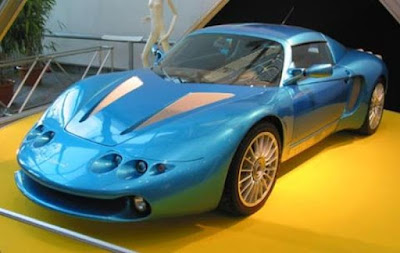Maestro WORKS - Luigi 'Lutz' Colani, a legendary figure in automotive design, brought his visionary touch to numerous projects, but one that stands out for its mystery and intrigue is his concept for the Dodge Stealth. This unique design, often referred to as the Luigi Colani Blue Car, reimagined the controversial Dodge Stealth, a car that found itself at the center of national debates about American identity in the early 1990s. Colani’s interpretation breathed new life into the Stealth, taking it beyond the limits of its original concept and influencing future designs in the process.
 |
| The Dodge Stealth Concept by Luigi Colani, also known as the Colani Blue Car, was displayed at the Colani Design Museum. (Picture from: CultObjects in Flickr) |
 |
| The Colani Blue Car is said to be a design built for the Dodge Stealth, based on Mitsubishi's Z16A platform, which is shared with the Mitsubishi GTO/3000GT. (Picture from: CultObjects in Flickr) |
Amid this controversy, Luigi Colani’s design for the Dodge Stealth emerged. While it’s unclear whether Colani was officially commissioned by Chrysler or whether this was an independent project, his design transformed the Stealth in a way that was uniquely his. Colani’s take on the car featured his signature bio-design language, with fluid, organic shapes that made the vehicle look like it was in motion even when standing still. The front fascia, with its elongated nose and double headlights, gave the car an almost otherworldly appearance, blending aerodynamic efficiency with Colani’s artistic vision. The rear, reminiscent of American muscle cars like the Camaro, added a sense of raw power and speed to the design.
 |
| Luigi Colani posed alongside his car creations, such as the Mamba Concept, Ferrari Testa D'Oro, and many others. (Picture from: RawViper) |
Although the Luigi Colani Dodge Stealth concept didn’t reach mass production, it showcased Colani’s ability to reinterpret a vehicle at the center of a national debate and turn it into something bold and futuristic. His design pushed the boundaries of what the Dodge Stealth could be, moving it away from the controversy surrounding its Japanese roots and into the realm of art and innovation.
 |
| The Colani Mamba Concept, when viewed as a whole from the front, reveals a unified design where the flowing lines and curves come together to resemble the shape of a Mamba snake's head. (Picture from: Sumally) |
Interestingly, Colani’s work on the Dodge Stealth seemed to have a lasting influence on his later designs. In the late 1990s, Colani revisited the Dodge brand, creating several remodels of the Dodge Viper in collaboration with Autohaus Getra, a German automotive company. His work on the Viper, including the Mamba Concept, featured striking elements that echoed his earlier Stealth design. The distinctive double headlights and flowing lines that characterized the Colani Blue Car reappeared in these remodels, suggesting that Colani’s experience with the Stealth left a lasting impact on his design philosophy.
 |
| The Colani Shark Speedster was designed and built by Luigi Colani in collaboration with the German auto design house Reinhard Stahl. (Picture from: Autoweek.nl) |
Colani’s work in the early 2000s further demonstrated the influence of his Dodge Stealth concept. One notable example is the Colani Shark Speedster, a design that emerged in collaboration with Reinhard Stahl, a German auto design house. The Shark Speedster, with its sleek lines and futuristic aesthetic, bore a resemblance to the Colani Blue Car, particularly in its front fascia. It’s as though Colani took the DNA of the Stealth design and refined it for the next generation of his work. | zF4wJglSr_8 |
 The Luigi Colani Dodge Stealth concept stands as a testament to the designer’s ability to turn controversy into creativity. Where others saw a car mired in debates about national identity, Colani saw an opportunity to push boundaries and redefine what the Stealth could be. His Blue Car design, with its organic shapes and radical ideas, not only reimagined the Stealth but also laid the groundwork for future projects, leaving an indelible mark on automotive design well into the 2000s. *** [EKA | FROM VARIOUS SOURCES | COLANI | COLANI.ORG | CULTOBJECTS IN X | BUBBLEMANIA.FR | STORY-CARS | RAWVIPER | DODGEGARAGE | MOPARINSIDERS | REDDIT WEIRDWHEEL ]
The Luigi Colani Dodge Stealth concept stands as a testament to the designer’s ability to turn controversy into creativity. Where others saw a car mired in debates about national identity, Colani saw an opportunity to push boundaries and redefine what the Stealth could be. His Blue Car design, with its organic shapes and radical ideas, not only reimagined the Stealth but also laid the groundwork for future projects, leaving an indelible mark on automotive design well into the 2000s. *** [EKA | FROM VARIOUS SOURCES | COLANI | COLANI.ORG | CULTOBJECTS IN X | BUBBLEMANIA.FR | STORY-CARS | RAWVIPER | DODGEGARAGE | MOPARINSIDERS | REDDIT WEIRDWHEEL ]Note: This blog can be accessed via your smart phone.

No comments:
Post a Comment